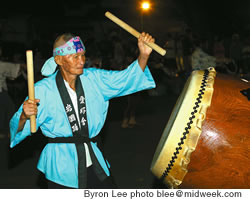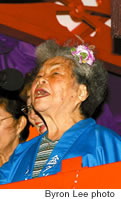Bon Dancing The Summer Away
It’s historic, it’s cultural, it’s religious, and most of all it’s a fun part of Hawaii culture. MidWeek’s intrepid reporter goes out to experience bon dancing, and offers a few bon mots on the subject

Ken Kunichika bangs the taiko drum
The ladies in the center circle wear purple and orange yukatas, a light kimono made of cotton with an obi (belt), tabi (white socks) and getta (straw or rubber slippers). Others wear a hapi, a short type of jacket resembling the top portion of a yukata.
The sight is quite extraordinary - everyone smiling and laughing and dancers wearing all types of footwear, from slippers to sneakers.
While each dancer wears either a yukata or hapi, clubs wear the same color of each to identify themselves. Herman points out a group of ladies of the Fukushima Bon Dance club wearing bright pink hapis adorned with black Japanese lettering on the front.
“They’re from Kaneohe,” he says. “They charter a bus to come here.”

Shizue Ishihara belts
out a song
Herman’s club wears turquoise-colored hapis, similar to those of the “pink ladies” of Kaneohe. However, there is one member of the Iwakuni that has chosen to stray from the norm when it comes to his look.
Meet Dazzman Toguchi. He’s a young man with spiky hair, donning a camouflage hapi. Toguchi has been with the club 14 years.
“I dance and drum for an Okinawan club and do professional Japanese stage dancing, as well. We had a bon dance when I was in fifth grade and I became interested then,” says the 23-year-old Honolulu resident, who adds that dancing is special to him because it means “Perpetuating my Japanese culture, the people who came before me, my ancestors.”

Guy Matsumoto and Cara Tsutsuse play flutes for
the dancing
The recorded music stops and it’s now time for the drummers, including Herman and fellow club member Colleen Izutsu, and the chanters to take the stage. Drummers take turns pounding their sticks on the large taiko drums, the sound echoing in the room. Iwakuni president Dennis Kanemori starts the chanting and a new dance begins.
The season’s remaining dances are:
Aug. 26: Aiea Hongwanji, 7 p.m.
Sept. 2-3: Okinawan Festival, Kapiolani Park (call 676-5400 for details)
Sept. 16: Autumn Matsuri, Hawaiian Okinawan Center at Waipio Gentry, 5 p.m. (call 676-5400 for directions)
Page 2 of 2 pages for this story < 1 2
E-mail this story | Print this page | Comments (0) | Archive | RSS
Most Recent Comment(s):








